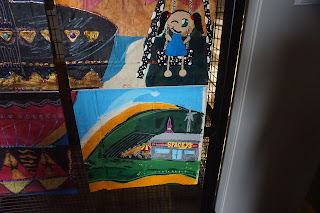by ilocopana "High School Life"
Saturday, June 4, 2016
Monday, May 23, 2016
Monday, February 1, 2016
Painting a Multi-Indigenes image
It starts with a simple blank canvas. Standing in front of a canvas, the thoughts, the ideas all that are running through the mind of an artist as it begins this overwhelming feeling of fear. Asking oneself what do I create? What will work as an image? Will this image communicate what I am trying to say on this canvas? Many seasoned artists have a rough time facing and immersing their skills, from a blank canvas to a work of art. Speaking as an artist/educator I like to think that teaching students to paint is an adventure, a sort of discovery to express a process of communication. It becomes a journey that will push a students to an uncomfortable place. In today's world I don't believe that there are many if any on a university level professors teaching these sophisticated, complex concepts of painting while providing a basic comprehensive and easy to follow method of painting as well as a high school setting. The task is to explore and understand many cultures by adding and applying each study as a layer on the same canvas. Painting a multi-indigenous style image for a high school student is perplexing and can easily go over the head of a student but by starting with a simple and easily accessible informative study the origin of designs (Islamic and Moorish), for this assignment all students, are asked to research where symmetry all started. Designs from this culture were never formulated or given to much order, not until artisans, craftsmen were demanded by the religious hierarchy of the day (circa 200-300AD) to create and craft designs found in tiles and decorative details of architectural structures. It is in this idea of reaching perfection that allowed the Moors to form the beginnings what we know now as symmetry. As a class, all students are required to draw up a designs of symmetry. Which in turn starts the process of painting a multi-indigenous work. The first layer is symmetrical painted in color. Once completed we roll forward in time and travel over to Panama where a tribe of Kuna creates a style of their own called "MOLA" these designs are very colorful mostly asymmetrical (more natural) with colorful outlines of each form and shapes. The Mola style designs are studied and applied over the layer of symmetry on canvas. Using this application students begin to see and understand the differences as well a the close similarities of indigenous culture while creating a painting of extraordinary visual strength. The last and final layer student are again asked to research the indigenous tribes of Australia,
the Aborigine, like the Kuna of Panama, have a style that identifies its own culture. Once the research is completed and the images are selected and kept for reference. The Aboriginal dot painting is added to yet another layer of the existing painting in process. As the completions of this assignment draws to an end the most extraordinarily striking visual images emerge. I am very pleased with the results made by the students and the tumultuous circumstances that become a part of the journey that allows for extraordinary results.
Halsey Academy HS
Elizabeth N.J.
Marco Muñoz Jaramillo
Thursday, January 28, 2016
Tuesday, January 26, 2016
Saturday, January 23, 2016
Painting Cultures by history and design
https://www.youtube.com/watch?v=f2TPrMqBRuEhttps://www.youtube.com/watch?v=f2TPrMqBRuE
Saturday, January 16, 2016
Culture by Design a hybrid Painting
 Painting is a challenge to any artist, let alone creating something new. Here is an assignment that is a blending of cultures by their designs as well as historic implications. Although these paintings are in progress and is only the first stage and layer "Symmetry". I allowed the assignment to be expressive and interpretive with the embracing the origin of visual reference. A few of the students have crossed over to the second part and layer infusing the elements and components of "MOLA". The Kuna people of Panama are a simple tribe who are known for their colorful clothings decorated with colorful designs of
Painting is a challenge to any artist, let alone creating something new. Here is an assignment that is a blending of cultures by their designs as well as historic implications. Although these paintings are in progress and is only the first stage and layer "Symmetry". I allowed the assignment to be expressive and interpretive with the embracing the origin of visual reference. A few of the students have crossed over to the second part and layer infusing the elements and components of "MOLA". The Kuna people of Panama are a simple tribe who are known for their colorful clothings decorated with colorful designs of
I'm very excited to see how a student can begin to appreciate the uses of materials playing of painting and by default learning of history and its importances, cultures unknown and geographic locations through the eyes of focusing attention within an assignment.
Subscribe to:
Posts (Atom)






























































